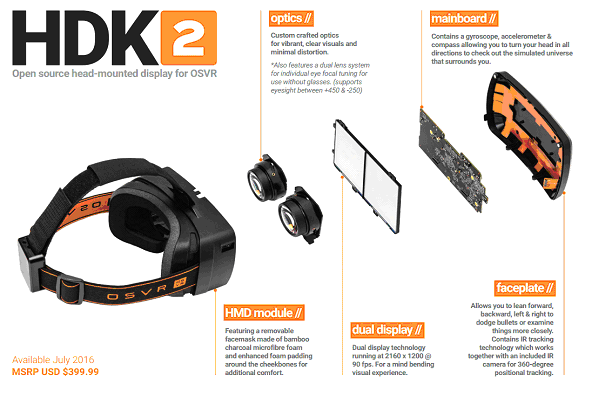The Open Source Virtual Reality (OSVR) platform has gone through several iterations since it was launched by Razer in collaboration with companies including Sensics. Earlier this year in March, the OSVR Hardware Development Kit (HDK) v1.4 launched, with a diffusion film and extra padding among some of the new features. Announced today comes a new hardware update called HDK 2, with a significant new addition, dual screens.
The OSVR HDK 2’s upgraded display features an OLED dual-display giving a total resolution of 2160×1200, putting the head-mounted display’s (HMD) visual experience on par with Oculus Rift and HTC Vive. Also added is an Image Quality Enhancer (IQE) reducing the screen door effect. This means that the hardware specifications for OSVR HDK 2 are capable of displaying VR experiences at 90 frames-per-second.
The full specifications are as follows:
Face Plate Module: IR Faceplate providing positional information with 360 degree tracking for responsive, multi directional input. Comes with an IR Camera operating at 100hz.
Mainboard: Sensor hub with integrated accelerometer, gyroscope and compass ; External USB 3.0 connection for additional accessories; Additional 2 x USB 3.0 connectors for internal expansion; Re-programmable for additional functionality.
Display Module: Dual Display 2180×1200 display technology running at 90fps. Features a low persistence OLED silver screen with 441 PPI. IQE (Image Quality Enhancer) technology for reduced screen door effect.
Optics Module: High performance dual lens system for ultra-sharp images; Enlarged eye-box for fuss-free setup, right out-of-box; Low geometric distortion and color corrected image for faster rendering; Individual eye focus for personalized use without glasses; *diopters cover +4.5 to -2 adjustments to cater to majority of users.
HMD Mechanical Module: Removable face mask; Bamboo charcoal microfiber foam layer for additional comfort; Thicker foam padding for cheekbones & nose bridge rubber insert for enhanced comfort.
Belt Box Module: Additional USB 3.0 connectivity; Surround Sound Audio codec integrated; Easier cable management and ergonomics; Signal boosters.
The new version will ship in July 2016, retailing for $399 USD, while the OSVR HDK 1.4 will continue to be sold at $299.
Razer will be demoing the OSVR HDK 2 at its booth during this weeks Electronic Entertainment Expo (E3) in Los Angeles, California. Also available for demo at E3 will be the Gloveone motion tracking gloves from Neurodigital Technologies. Upon public release, the gloves will be available as a controller option for the HDK and all OSVR supporting HMDs in the open ecosystem.
VRFocus will continue its OSVR coverage, reporting back with the latest updates.















